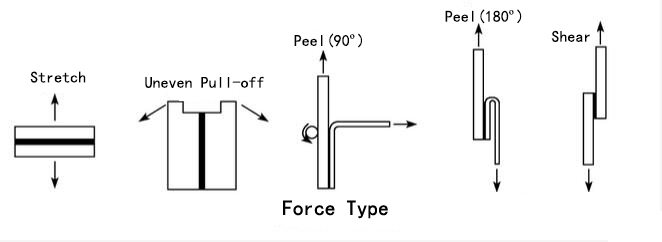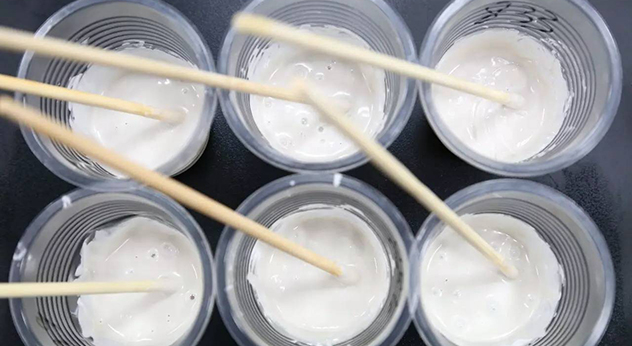The most commonly used method for evaluating bonding quality is to measure bonding strength. Characterization of adhesive performance often requires strength data. Bonding strength is an important indicator of adhesive technology. It is very helpful for selecting adhesives, developing new types of adhesives, designing joints, improving bonding processes, and applying adhesive structures correctly. significance.
1. Definition of bonding strength
Adhesive strength refers to the stress required to damage the interface between the adhesive in the adhesive and the adherend or its vicinity under the action of external force. The adhesive strength is also known as the adhesive strength.
Adhesive strength is the stress required for the failure of the adhesive system. Its magnitude not only depends on the adhesive force, the mechanical properties of the adhesive, the nature of the adherend, and the bonding process, but also the joint form and stress condition (type, Size, direction, frequency), environmental factors (temperature, humidity, pressure, medium) are related to test conditions and experimental techniques. It can be seen that adhesive strength is only one of the important factors that determine adhesive strength, so adhesive strength and adhesive strength are two concepts with completely different meanings and must not be confused.
2. The force form of the bonded joint
The force on the adhesive layer of the adhesive joint under the action of external force can be summarized into four forms: shearing, stretching, uneven pull-off and peeling.

(1) Shear. The external force is equal in magnitude and opposite in direction, basically parallel to the bonding surface, and evenly distributed on the entire bonding surface.
(2) Stretching. Also known as uniform pull-off, it is perpendicular to the bonding surface and is evenly distributed on the entire bonding surface under the action of the pulling force in the opposite direction.
(3) Uneven pull-off. It is also called cleavage. Although the direction of external force is perpendicular to the bonding surface, the distribution is uneven.
(4) Peeling. The direction of the external force is at a certain angle to the bonding surface, and the above four forces are basically distributed on a straight line of the bonding surface. There are likely to be several forces in the same adhesive system. It is only a question of which one is the main one.
3. Classification of bonding strength
According to the different forces of the bonded joints, the bonding strength can be divided into shear strength, tensile strength, uneven pull-off strength, peel strength, compressive strength, impact strength, bending strength, torsional strength, fatigue strength, and creep resistance. Change the intensity and so on.
(1) Shear strength
Shear strength refers to the shear force that the unit bonding surface can withstand when the bonding part is broken, and its unit is expressed in megapascals (MPa).
The shear strength is divided into tensile shear, compression shear, torsion shear and bending shear strength according to the stress mode during the test.
Adhesives with different properties have different shear strengths. In general, tough adhesives have higher shear strengths than flexible adhesives. A large number of tests have shown that the thinner the thickness of the adhesive layer, the higher the shear strength.
The test conditions have the greatest influence on the ambient temperature and test speed. As the temperature increases, the shear strength decreases, and as the test speed slows down, the shear strength decreases. This shows that the temperature and the speed have an equivalent relationship, that is, increasing the test temperature is equivalent to Reduce loading speed.
(2) Tensile strength
Tensile strength, also known as uniform pull-off strength and positive tensile strength, refers to the tensile force per unit area when the viscous force is broken, and the unit is expressed in megapascals (MPa).
Because stretching is much more uniform than shearing, the tensile strength of general adhesives is much higher than the shearing strength. In the actual measurement, under the action of external force, because the deformation of the adhesive is greater than that of the adherend, the different axiality of the external force is likely to cause shear and lateral compression. Therefore, it will be broken at the time of tearing. There may be simultaneous fractures. If the length of the sample can be increased and the bonding area can be reduced, the effect of peeling during tearing can be reduced, and the stress distribution can be more uniform. The influence of elastic modulus, thickness of adhesive layer, test temperature and loading speed on tensile strength is basically similar to that of shear strength.
(3) Peel strength
Peel strength is the maximum load that can be withstood per unit width when the adhesive is separated under specified peeling conditions, and its unit is expressed in kN/m.
There are many types of peeling, generally divided into L-shaped peeling, U-shaped peeling, T-shaped peeling and curved surface peeling, as shown in the figure below.

As the peeling angle changes, the peeling form also changes. When the peeling angle is less than or equal to 90°, it is L-shaped peeling, and when the peeling angle is greater than 90° or equal to 180°, it is U-shaped peeling. These two forms are suitable for the peeling of rigid materials and flexible materials. T-type peeling is used for peeling when two flexible materials are bonded.
The peel strength is affected by factors such as the width and thickness of the test piece, the thickness of the adhesive layer, the peel strength, and the peel angle.
(4) Uneven pull-off strength
Uneven pull-off strength indicates the maximum load that the bonded joint can withstand when it is subjected to uneven pull-off force. Because the load is mostly concentrated on the two edges or one edge of the adhesive layer, the force is per unit length instead of unit area. , The unit is kN/m2.
(5) Impact strength
Impact strength refers to the maximum work consumed per unit bonding area when the bonding part is damaged by the impact load, and the unit is kJ/m2.
According to the different joint form and force mode, the impact strength is divided into bending impact, compression shear impact, tensile shear impact, torsion shear impact and T-type peel impact strength.
The impact strength is affected by the toughness of the adhesive, the thickness of the adhesive layer, the type of adherend, the size of the test piece, the angle of impact, the environmental humidity, and the test temperature. The better the toughness of the adhesive, the higher the impact strength. When the modulus of the adhesive is low, the impact strength increases as the thickness of the adhesive layer increases.
(6) Durable strength
The endurance strength is the maximum load that the bonding part can bear after long-term static load, and the unit is expressed in megapascals (MPa).
The endurance strength is affected by the loading stress and test temperature, and the endurance strength decreases with the increase of the loading stress and temperature.
(7) Fatigue strength
Fatigue strength refers to the maximum stress at which a certain load is repeatedly applied to the bonded joint to a specified number of times without causing damage. Generally, the fatigue strength at 10 times is called the fatigue strength limit.
Generally speaking, adhesives with high shear strength have lower peel, bending, and impact strengths; while adhesives with higher peel strength have higher impact and flexural strengths. Different types of adhesives have very different strength characteristics.
